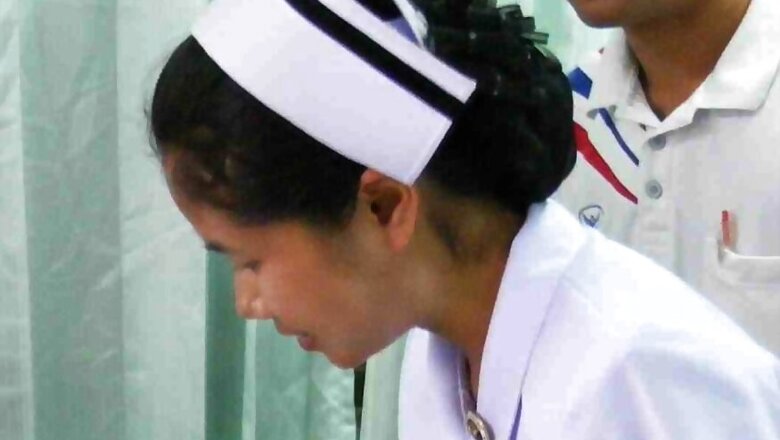
views
Manila (Philippines): There were seven nurses in the Buendia family. One of them, Jhoanna Mariel Buendia, got a call from the Philippines on March 28, just before the start of her shift at an intensive care unit in a British hospital.
It was her father, with the news that her beloved aunt — an ICU nurse in Florida — had died of complications from COVID-19, the disease caused by the coronavirus.
Buendia, 27, went to work. She suited up, strapping on her N95 mask, face shield, gown and apron and taping down her gloves, too numb to process the fact that her aunt had lost her life doing what she was about to do. It wasn’t until a few hours later, as she tended to a patient suspected to have the virus, that it became real and she burst into tears.
Nurses from the Philippines and other developing countries have long made up for shortages in wealthier Western nations. They now find themselves risking their lives on the front lines of a pandemic, thousands of miles from home.
Buendia’s aunt, Araceli Buendia Ilagan, 63, was an associate supervisor in the cardiac surgical ICU at Jackson Memorial Hospital in Miami. She was remembered as a nurses’ nurse, turning down administrative promotions that would have taken her away from patients’ bedsides.
“I guarantee you. She was in every single room helping every single nurse with every single patient,” said Martha Baker, a registered nurse and president of Jackson Memorial’s union for doctors and nurses, who had known Ilagan since the 1980s.
“That was probably her doom,” Baker said. “To be such a good leader and such a hands-on leader. She exposed herself, perhaps at that time to patients we didn’t even know were COVID-positive.”
According to the World Health Organization, the world has 6 million fewer nurses than it needs. One result is that nurses in places like the Philippines have long gravitated toward wealthier countries for higher-paying opportunities.
Almost 16% of nurses in the United States are immigrants, and nearly a third of those — the largest share — are Filipinos. Many also come from Nigeria, India, Jamaica and Mexico, among other places. In Britain, Buendia is one of about 18,600 Filipino nurses working for the National Health Service, its second-largest contingent of migrant nurses, after Indians.
Like other medical professionals, they are at high risk of exposure. At least seven Filipino employees of the NHS, including nurses, porters and a nurse’s assistant, have died from COVID-19, according to news reports. In the United States, the virus has claimed the lives of at least five nurses and a doctor from the Philippines.
“The common denominator is that we’re all scared,” Buendia said of herself and her three housemates, who are also Filipino nurses.
They all work at the same hospital in York and have been in England since September.
Howard Catton, chief executive of the International Council of Nurses, a federation of national nurse associations, said migrant nurses had been “massively important” in helping countries like Britain, Spain and Italy fight the virus.
But he said the crisis underscored the need for developed countries to train their own nurses rather than relying so heavily on migrants.
This month, the Philippines, which says it needs about 300,000 more health care workers than it has, barred them from leaving the country, citing the need to protect them from infection and to ensure they were available to fight the virus at home.
Migration is woven into the Philippines’ culture. As much as 10% of the population works overseas, sending money home, and nursing is one of the most popular options. On average, 13,000 nurses go abroad each year. Nursing recruitment agencies pave the way for visas and certifications so they can find jobs overseas.
Even some Filipino migrants who work in other fields have had training in nursing. Last month in Madrid, the Filipino chief nurse at Hospital Hestia, Edzel Lopez, posted an urgent call on Facebook asking her compatriots to apply for nursing jobs there. Much of the hospital’s staff had been infected by the coronavirus, and bureaucratic obstacles to hiring new nurses were being swept away.
The Spanish hospital hired John Matthew Eusebio Villapol, a 26-year-old from the city of Tagaytay, who was working as an English teacher but had experience training Philippine army medics and working for private ambulance services.
“It was a battlefield promotion, so to speak,” Villapol said.
After a day of training, Villapol said, he was assigned half a floor’s worth of patients. He planned to report for work on his second day off, knowing they would be short-staffed however many people showed up.
“I’ll work if they’ll have me,” he said.
Buendia’s family, whose roots are in the northern Philippine city of Baguio, has sent nurses to hospitals in Florida, California, Britain and Saudi Arabia.
Buendia joined the profession to follow in her aunt’s footsteps. Ilagan helped her through college, sending money and guiding her through tough times in nursing school. She mentored Buendia from a distance as the young nurse began her career in Saudi Arabia, later moving to Britain.
Ilagan called Buendia late last month, as the gravity of the pandemic was becoming apparent in both of the countries where they worked. Coronavirus cases had begun turning up at their hospitals.
It was a conversation of familial concern, couched in the language of their shared profession. They chatted about basic infection protocol. Ilagan gave her niece tips, like how to disconnect patients from tubing in a way that would keep fluids from spattering her. They reassured each other that they were fine.
It was the last time they spoke. Soon afterward, Ilagan developed flu-like symptoms and began self-isolating at home. Four days later, her husband found her unconscious and struggling to breathe. He rushed her to the hospital, but she died before they could intubate her.
“I was so shocked,” Buendia said.
Since then, her uncle, a nurse in California, has tested positive for the virus and been hospitalized.
Buendia’s parents have been calling her from the Philippines every day, often in tears.
“They can’t sleep at night,” she said. “I reassure them that I’m fine.”
In truth, she is afraid. But she has no thoughts of giving up the work.
“That’s the reason why I’m here, to be a nurse,” she said.
Aurora [email protected] The New York Times Company

















Comments
0 comment